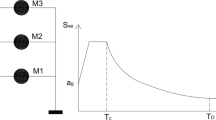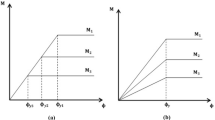Abstract
In this paper, a displacement-based design (DBD) methodology commonly used for seismic design and evaluation of structures is adopted to determine the performance of structures to blast loading. In this method, structural performance is linked to measurable quantities such as the displacement ductility. To verify the applicability of the method and the accuracy of the results, a simple structural shape, including a square steel plate, is subjected to out-of-plane blast loading with different explosive charge weights and stand-off distances. With the adaptation of the autodyn software, the above-mentioned examples in a similar condition are also subjected to blast loading. It is found that the results of the DBD method agree favorably with the results obtained from a numerical method. It is also shown that a good prediction of the damage level can be made for steel plates subjected to different charge weights and stand-off distances.
Similar content being viewed by others
References
P. D. Smith and J.G. Hetherington, Blast and Ballistic Loading of Structures, Butterworth-Heinemann Ltd., (1994).
M. J. N. Priestley, Performance Based Seismic Design, Proceeding of the 12th world conference on Earthquake Engineering, Auckland, New Zealand, State of the Art Paper, 2831 (2000) 325–346.
G. F. Kinney and K. J. Graham, Explosive Shocks in Air, 2nd ed, Berlin, Springer, (1985).
TM5-1300, Design of Structures to Resist the Effects of Accidental Explosions, US Department of the Army, Technical Manual, (1990).
N. Lam, P. Mendis and T. Ngo, Response Spectrum Solution for Blast Loading, Electronic Journal of structural Engineering, 4 (2004).
G. R. Johnson and W. H. Cook, Fracture Characteristics of Three Metals subjected to various strains, strain Rates, Temperatures and Pressures, Engineering Fracture Mechanics, 21(1) (1985) 31–48.
S. D. Borvik, T. Hopperstad and M. Langseth, on the Influence of Fracture Criterion in Projectile Impact of steel plates. Computational Materials Science, 38(1) (2006) 176–191.
S. C. K. Yuen and G. N. Nurick, Experimental and Numerical studies on the Response of Quadrangular stiffened Plates. Part I: Subjected to Uniform Blast Load, International Journal of Impact Engineering, 31(1) (2005) 55–83.
G. R. Johnson and W. H. Cook, A Constitutive Model and Data for Metals Subjected to large Strains, High Strain Rates and High Temperatures in Proceedings of the 7th International symposium on Ballistics. The Hague, The Netherlands, (1983) 541–547.
T. Umeda, H. Umeki, and K. Mimura, Numerical Evaluation of Measurement Accuracy of Non-Coaxial Hopkinson Bar Method, JSME International Journal, Series A, 48(4) (2005) 215–221.
R. W. Clough and J. Penzein, Dynamics of Structures, New York, McGraw Hill, Inc., (1978).
AUTODYN User Manual, Century Dynamics. Version 6.1 (2005).
Author information
Authors and Affiliations
Corresponding author
Additional information
This paper was recommended for publication in revised form by Associate Editor Jeonghoon Yoo
R. A. Izadifard received his Ph.D. in Civil Engineering from Shiraz University. He is currently a faculty member of the Department of Civil Engineering, Imam Khomeini University, Iran. He is a member of several national committees on structural engineering codes of practice and construction. His current research interests are structural analysis and design under extreme loads, seismic analysis, and fluid-structure dynamic interaction.
Mahmoud R. Maheri received his Ph.D. in Civil Engineering from Bristol University, UK, in 1987. Professor Maheri is currently a faculty of the Civil Engineering department of Shiraz University, Iran. He is a core member of the Iranian Centre of Excellence in Computational Mechanics. He also serves on several national committees on structural and earthquake engineering codes of practice. Professor Maheri’s current research interests include seismic analysis and retrofitting of structures and fluid-structure dynamic interaction.
Rights and permissions
About this article
Cite this article
Izadifard, R.A., Maheri, M.R. Application of displacement-based design method to assess the level of structural damage due to blast loads. J Mech Sci Technol 24, 649–655 (2010). https://doi.org/10.1007/s12206-009-1218-2
Received:
Revised:
Accepted:
Published:
Issue Date:
DOI: https://doi.org/10.1007/s12206-009-1218-2




